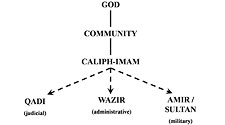Module Overview
Explore the path of political power and authority from 610 CE, the classical period of Islamic civilization, until the dissolution of the Ottoman Empire in the early years of the twentieth century.
Essay
- Introduction
- Muhammad and the First Muslim Ummah: The Beginning of a New Society and Culture
- The Death of the Prophet and the First Elaboration of the Sunnī-Jamā‘ī Imamate
- The Shī‘ī Political Vision
- Structure of the First Sunnī-Jamā‘ī Imamate (632-661 CE)
Framing the Issues
- The Qur’an and Sovereignty
- Advice on Leadership from the Hadīth
- Medieval Commentaries on Sovereignty and Government
Examining Stereotypes
Image Resource Bank

During the period of the Rāshidūn caliphate, executive authority was concentrated primarily in the hands of the caliph-imām, and he served the community as the chief administrator, military commander, and jurist. However, as the state grew, the maintenance of a large bureaucratic system required the caliph-imām to transfer these responsibilities to trusted deputies through a process of delegation... [IMAGE GALLERY]
Learning Resources

 John Woods
John Woods
Professor of Iranian and Central Asian History, and of Near Eastern Languages & Civilizations
 Alexander Barna
Alexander Barna
Outreach Coordinator, Center for Middle Eastern Studies, University of Chicago
Classroom Connections
LESSON 1: The Book of Golden Meadows: Evaluating The Early Caliphs
LESSON 2: What IS the difference between Sunni and Shi'ite Muslims?



